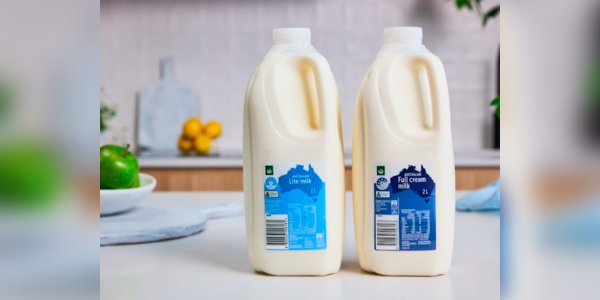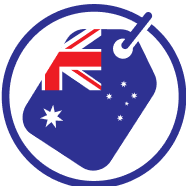Major change at Woolworths set to affect their own brand milk
By
VanessaC
- Replies 11
In a move that’s sure to benefit millions of shoppers and the environment, supermarket giant Woolworths has announced that they are making a particular change to their milk cartons.
This will be done in hopes of making a big difference to the recycling habits of consumers.
Currently on a trial phase, Woolies have switched their milk cartons from coloured lids to clear ones.
The change came into effect this week in selected Woolworths stores in Victoria, NSW and Queensland, and they’re hoping to roll out the rest of the country by early next year.
But why is the change being made?
According to Woolworths, their hope is that the transition will make recycling easier.
The clear colour of the trial lids—which used to be dark blue or light blue—allows the plastic to be more effectively recycled into a greater variety of new products, as coloured plastic is less used when recycling.
The supermarket expects up to 290,000 kg of plastic from millions of milk bottles to be recycled yearly.
'We’re pleased to be the first Australian supermarket to start the switch for our own brand milk to help our customers’ good recycling habits go further,' Woolworths Dairy Merchandise Manager Will Herron shared.
'Our customers are pretty cluey—so we expect them to spot the change, but it’s important they know why their milk bottle looks a little different.'
'This small change will lead to better recycling for millions of milk bottles once it rolls out across our range.
'We also want to take this opportunity to remind our customers to reattach their milk lids when the bottle goes into the recycling bin to ensure it gets properly recycled into a new product.’
During the recycling process, coloured plastic is separated from clear plastic.
While coloured plastic can still be recycled, the coloured pigment on the plastic can only be recycled into dark-coloured plastics, making it less versatile than clear plastic.
The clear lids mean that the plastic can be recycled into clear or coloured plastic, potentially becoming new milk bottles.
Australian Packaging Covenant Organisation (APCO) CEO, Chis Foley said, 'Small changes like this stack up to help recycled material go into a greater variety of new products, and we hope to see more companies follow this move.'
'Customers should always look for the Australasian Recycling Label logo on their Woolworths brand milk and other supermarket products for easy-to-follow instructions to ensure their packaging ends up in the right place.'
Did you know the magnitude of the plastic waste problem our beloved Mother Earth is grappling with?
Every year, Australians churn out an estimated 3.5 million tonnes of plastic. An issue of particular concern is that all this plastic, if not properly managed, lands in our oceans, harming the marine ecosystem and threatening our very survival.
According to CSIRO (Commonwealth Scientific and Industrial Research Organisation), approximately 8 million metric tons of plastic enter our oceans annually, creating an ecological nightmare for marine life.
Plastic waste not only affects marine life but also contributes to greenhouse gas emissions and climate change.
Here's the lowdown: when plastic waste disintegrates in the environment, it releases potent greenhouse gases like methane and ethylene into the Earth's atmosphere, aggravating the global warming crisis even further.
 Let’s fulfill our role as savvy and sustainable shoppers and share this article with others so they can do the same to help save our planet.
Let’s fulfill our role as savvy and sustainable shoppers and share this article with others so they can do the same to help save our planet.
What are your thoughts on this recent change, members? Let us know in the comments below!
This will be done in hopes of making a big difference to the recycling habits of consumers.
Currently on a trial phase, Woolies have switched their milk cartons from coloured lids to clear ones.
The change came into effect this week in selected Woolworths stores in Victoria, NSW and Queensland, and they’re hoping to roll out the rest of the country by early next year.
But why is the change being made?
According to Woolworths, their hope is that the transition will make recycling easier.
The clear colour of the trial lids—which used to be dark blue or light blue—allows the plastic to be more effectively recycled into a greater variety of new products, as coloured plastic is less used when recycling.
The supermarket expects up to 290,000 kg of plastic from millions of milk bottles to be recycled yearly.
'We’re pleased to be the first Australian supermarket to start the switch for our own brand milk to help our customers’ good recycling habits go further,' Woolworths Dairy Merchandise Manager Will Herron shared.
'Our customers are pretty cluey—so we expect them to spot the change, but it’s important they know why their milk bottle looks a little different.'
'This small change will lead to better recycling for millions of milk bottles once it rolls out across our range.
'We also want to take this opportunity to remind our customers to reattach their milk lids when the bottle goes into the recycling bin to ensure it gets properly recycled into a new product.’
During the recycling process, coloured plastic is separated from clear plastic.
While coloured plastic can still be recycled, the coloured pigment on the plastic can only be recycled into dark-coloured plastics, making it less versatile than clear plastic.
The clear lids mean that the plastic can be recycled into clear or coloured plastic, potentially becoming new milk bottles.
Australian Packaging Covenant Organisation (APCO) CEO, Chis Foley said, 'Small changes like this stack up to help recycled material go into a greater variety of new products, and we hope to see more companies follow this move.'
'Customers should always look for the Australasian Recycling Label logo on their Woolworths brand milk and other supermarket products for easy-to-follow instructions to ensure their packaging ends up in the right place.'
Did you know the magnitude of the plastic waste problem our beloved Mother Earth is grappling with?
Every year, Australians churn out an estimated 3.5 million tonnes of plastic. An issue of particular concern is that all this plastic, if not properly managed, lands in our oceans, harming the marine ecosystem and threatening our very survival.
According to CSIRO (Commonwealth Scientific and Industrial Research Organisation), approximately 8 million metric tons of plastic enter our oceans annually, creating an ecological nightmare for marine life.
Plastic waste not only affects marine life but also contributes to greenhouse gas emissions and climate change.
Here's the lowdown: when plastic waste disintegrates in the environment, it releases potent greenhouse gases like methane and ethylene into the Earth's atmosphere, aggravating the global warming crisis even further.
Key Takeaways
- Woolworths supermarket is changing the lids on its milk cartons from coloured to clear, to make recycling easier.
- Woolworths expects to roll out the change across all stores by early next year, potentially improving the recycling of 290,000 kilos of bottles per year.
- The improvement in recycling is due to clear plastics being turned into a wider range of new products compared to coloured plastics.
- Australian Packaging Covenant Organisation (APCO) CEO, Chis Foley encouraged customers to follow the Australasian Recycling Label logo on their supermarket products for appropriate instructions on recycling.
What are your thoughts on this recent change, members? Let us know in the comments below!








